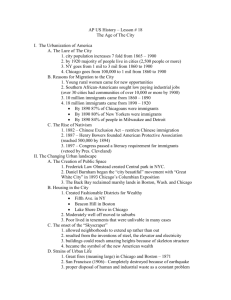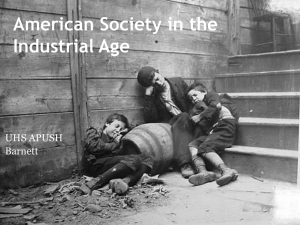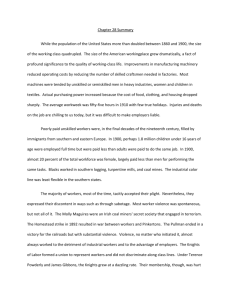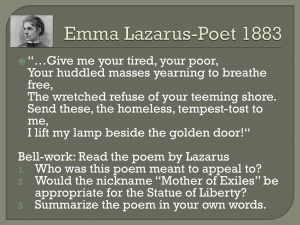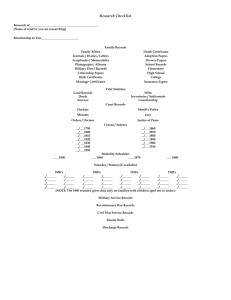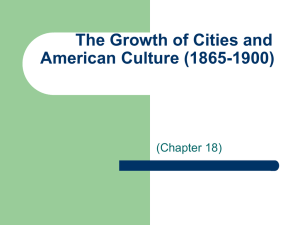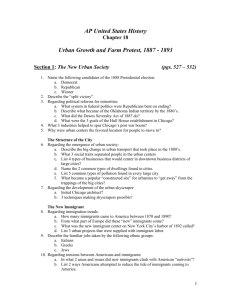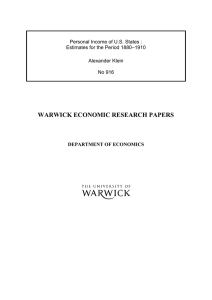APUSH lesson 17 (updated) Growth of Cities
advertisement
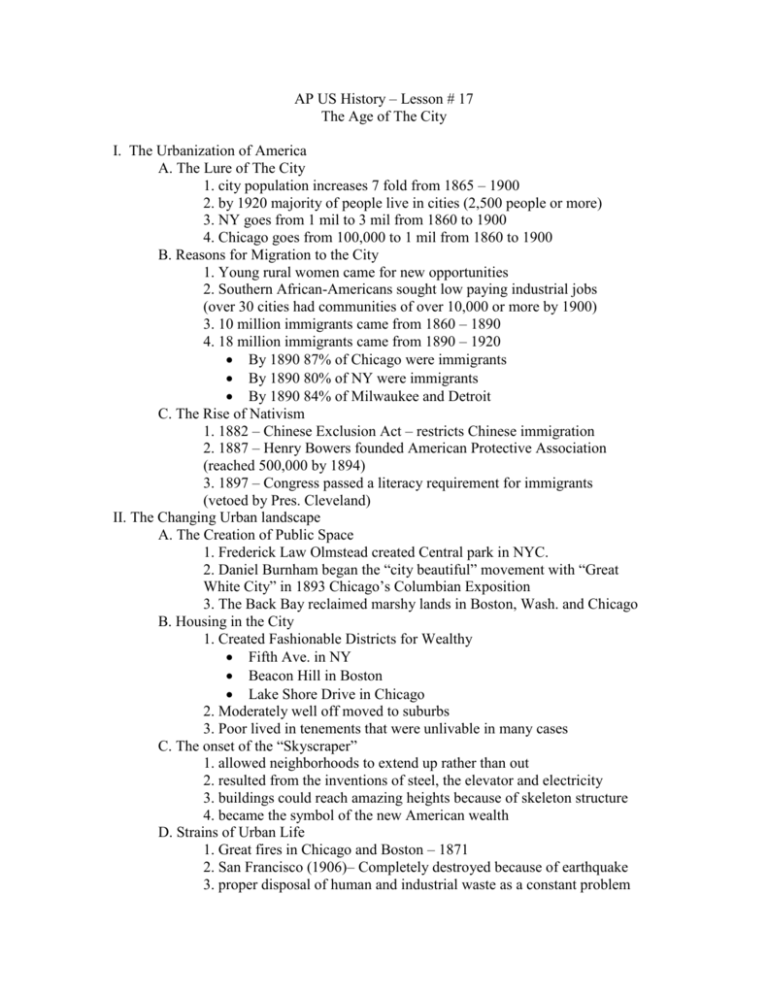
AP US History – Lesson # 17 The Age of The City I. The Urbanization of America A. The Lure of The City 1. city population increases 7 fold from 1865 – 1900 2. by 1920 majority of people live in cities (2,500 people or more) 3. NY goes from 1 mil to 3 mil from 1860 to 1900 4. Chicago goes from 100,000 to 1 mil from 1860 to 1900 B. Reasons for Migration to the City 1. Young rural women came for new opportunities 2. Southern African-Americans sought low paying industrial jobs (over 30 cities had communities of over 10,000 or more by 1900) 3. 10 million immigrants came from 1860 – 1890 4. 18 million immigrants came from 1890 – 1920 By 1890 87% of Chicago were immigrants By 1890 80% of NY were immigrants By 1890 84% of Milwaukee and Detroit C. The Rise of Nativism 1. 1882 – Chinese Exclusion Act – restricts Chinese immigration 2. 1887 – Henry Bowers founded American Protective Association (reached 500,000 by 1894) 3. 1897 – Congress passed a literacy requirement for immigrants (vetoed by Pres. Cleveland) II. The Changing Urban landscape A. The Creation of Public Space 1. Frederick Law Olmstead created Central park in NYC. 2. Daniel Burnham began the “city beautiful” movement with “Great White City” in 1893 Chicago’s Columbian Exposition 3. The Back Bay reclaimed marshy lands in Boston, Wash. and Chicago B. Housing in the City 1. Created Fashionable Districts for Wealthy Fifth Ave. in NY Beacon Hill in Boston Lake Shore Drive in Chicago 2. Moderately well off moved to suburbs 3. Poor lived in tenements that were unlivable in many cases C. The onset of the “Skyscraper” 1. allowed neighborhoods to extend up rather than out 2. resulted from the inventions of steel, the elevator and electricity 3. buildings could reach amazing heights because of skeleton structure 4. became the symbol of the new American wealth D. Strains of Urban Life 1. Great fires in Chicago and Boston – 1871 2. San Francisco (1906)– Completely destroyed because of earthquake 3. proper disposal of human and industrial waste as a constant problem 4. By 1912 federal government created Public Heath Service to deal with air pollution and create health standards for all cities 5. Crime rate rose from 25 murders per million in 1880 to 100 by 1900 6. Sister Carrie by Theodore Dreiser exposed the dangers of single females in large cities E. The rise of the political machine 1. The Boss rule became the way for immigrants to take care of their own 2. The Boss would win votes in exchange for occasional relief 3. Machines were ways for politicians to make money illegally 4. Tammany Hall became symbol of corruption with Boss Tweed in 1860’s and George Plunkitt of 1880’s and 1890’s 5. Did result in benefit for cities Took care of immigrants Modernized city infrastructures Stabilized the social climate Forced an expanded role of government III. The Rise of The Consumer Society A. Chain store and mail order catalogs increasing buying power 1. 1879 - F.W. Woolworth opens first store and builds a national chain 2. 1872 – Montgomery Ward begins a catalog of consumer goods 3. 1887 – Sears roebuck creates its own catalog in urban and rural areas B. Leisure becomes an accepted part of daily life 1. Mass entertainment becomes large part of social fabric 2. Public parks like Coney Island and Steeplechase park 3. Baseball, college football and horseracing become popular 4. Vaudeville becomes popular in cities 5. Movies become a popular medium (Birth of a Nation in 1915) IV. The Rise of Education A. Spread of Secondary Education 1. tax-supported high school were rare before the Civil War 2. By 1900 there were 6,000 high schools and free textbooks were normal B. Spread of College Education 1. Rise of women in colleges (1880 o 1 out of 3 grads was a woman) 2. Black Colleges on the Rise (Howard , Hampton, Atlanta Univer.) 3. Rise of Normal Schools (Teacher training colleges – 1910 – 300) 4. Morrill Act of 1862 – federal grant of public lands to sates that supported education (land grant colleges evolve in to state universities) 5. Hatch Act of 1887- provided grants for agricultural schools (Texas A&M, Univer. Of Calif., Ohio State Univer.) 6. Private philanthropy supports federal grants • Univer. Of Chicago – John D. Rockefeller • Carenigie- Mellon – Andrew Carnegie C. Spread of Intellectualism and pragmatism 1. William James – introduced the concepts of psychology 2. John Dewey – creating a method of learning that emphasized doing 3. Oliver Wendell Holmes – jurist and Supreme Court Justice D. Post War Writing 1. “Dime novels” depicted the wild west – Harlan F. Haslsy 2. “Ragged Dick” novels showed business success stories – Horatio Alger 3. Yellow Journalism brought news stories into the popular medium. (Joseph Pulitzer – NY World; William Randolph Hearst – SF Examiner) 4. The Age of Realism Walt Whitman – Leaves of Grass Emily Dickinson – collection of poetry Mark Twain – Adventures of Huck Finn Stephen Crane – Red Badge of Courage Jack London – The Call of the Wild Henry James – Daisy Miller Henry Adams – The Education of Henry Adams V. The Rise of Reform A. African –American rights 1. Civil Rights Act of 1875 gets overturned in the courts 2. Jim Crow Laws become the norm 3. Plessy v. Ferguson – separate but equal (1896) 4. Cummings v. County Board of Ed. (segregation in schools) (1899) 5. Booker T. Washington recommended accommodation Atlanta Compromise (1895) Encouraged stressed of vocational education over higher learning Argued black man needed to prove himself before demanding rights Started Tuskegee Institute in Ala. George Washington Carver was one of his famous instructors 6. W.E.B. DuBois recommended that blacks fight for equal rights Born free in Mass. First black to earn PhD from Harvard Wanted complete freedom and argued for the “talented tenth” Started both the Niagara Movement and the NAACP (1910) Argued against Booker T. Washington B. The New Feminism 1. Charlotte Perkins Gilman – Women and Economics – described a new breed of women who were to seek their own economics independence 2. Carrie Chapman Catt – National American Woman Suffrage Assoc. (linked the right to the ballot with traditional role of women) 3. Ida B. Wells – inspired black woman to protest lynching and to see the vote on their own (National Assoc. of Colored Women) C. The New Temperance Movement 1. Woman’s Christian Temperance Union(WCTU) formed in 1874 (Carrie Nation known for her hatchet and strong protest of saloons) 2. Anti-Saloon League (1893) – sought state prohibition (culmination of success ended with the 19 th amendment (1919)
